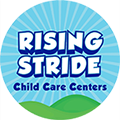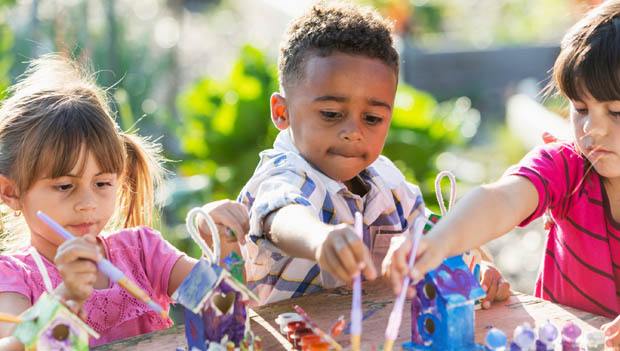Summer time brings a breath of fresh air for hands-on learning in the preschool classroom. As the weather warms and nature starts to bloom outside your classroom doors, it’s the perfect season to spark curiosity through outdoor exploration, sensory play, and spring art projects.
1. Summer Garden Sensory Bin
A sensory bin is a fantastic way to immerse little ones in hands-on learning activities while introducing early science concepts and connection to nature. This summer garden-themed bin lets children dig, plant, and explore textures while learning about nature.
Materials:
- Large plastic bin
- Potting soil or sand
- Small pots or cups
- Artificial spring flowers and leaves
- Mini gardening tools or spoons
- Plastic bugs and insects
- Gardening Gloves
Set-Up:
Fill the bin with soil or sand, then add small pots, artificial flowers, and plastic insects. Provide mini gardening tools and gloves so children can dig, plant, and re-arrange the items.
Teaching Tips:
- Set up a planting station in a second bin where children can “plant” the flowers they have dug up and sort them by color, size, or type.
- Introduce math activities by having learners count or classify plastic bugs and insects.
Learning Goals:
- Encourages sensory exploration.
- Develops fine motor skills.
- Introduces early science concepts about plants and insects.
2. Butterfly Craft with Coffee Filters
This simple spring art project lets preschoolers explore colors, patterns and textures while learning about butterflies.
Materials:
- Coffee filters
- Washable markers
- Spray bottle with water
- Pipe cleaners
Set-Up:
Place two coffee filters on top of each other and have children color coffee filters with markers. When they are done, have the children lightly mist their coffee filters with water, and watch as the colors blend together making a tie-dye effect (make sure not to soak the coffee filter). Once dry (depending on where you are drying them you might need to leave them overnight to dry), fold each coffee filter back and forth, accordion style, in about 1/2″ folds, until they are each in a strip. Put the two strips on top of each other and then tie a pipe cleaner around the middle, making antennae. Once the pipe cleaners are tied on children can gently pull apart the folded wings and watch their butterfly bloom!
Teaching Tips:
- Pair this craft with a read-aloud, such as The Very Hungry Caterpillar.
- Have the children bring their butterflies on a nature walk or to the playground while discussing where butterflies like to live.
- Use the butterflies to decorate a spring-themed bulletin board.
Learning Goals:
- Encourages creativity and self-expression.
- Strengthens fine motor coordination.
- Introduces basic color-mixing concepts.
3. Egg Carton Caterpillars
This eco-friendly craft helps young children understand the butterfly life cycle while strengthening fine motor skills.
Materials:
- Empty egg cartons
- Child-safe paint
- Paintbrushes
- Googly eyes
- Pipe cleaners
- Child-safe glue sticks
Set-Up:
Cut egg cartons into strips of three or four sections. Have children paint them as caterpillars. Once dry, have them use glue to attach googly eyes and pipe cleaner antennae.
Teaching Tips:
- Further this activity by having children plant potting soil and seeds in a separate section of their egg carton caterpillar and watch them grow! Be sure to poke small holes in the egg carton for draining.
- Read books about the butterfly life cycle during circle time, or place butterfly themed books in the reading section of your classroom to encourage preschoolers to further their own learning.
- Book Suggestions:
- The Very Impatient Caterpillar by Ross Burach
- Waiting for Wings by Lois Ehlert
- A Butterfly is Patient by Diana Huts Aston
- Book Suggestions:
Learning Goals:
- Develops fine motor skills through painting and gluing.
- Introduces the butterfly life cycle.
- Encourages imaginative play.
4. Paper Plate Ladybugs
Ladybugs are a classic symbol of spring for young children and often easy to spot outdoors, making them an engaging and easily relatable theme for preschoolers.
Materials:
- Paper plates
- Paint or crayons
- Black construction paper, tissue paper or pom poms
- Glue
- Pipe cleaners
Set-Up:
Have children paint a paper plate red (or any color they choose). Once dry, they can add black paper spots, googly eyes, and pipe cleaners for antennae.
Teaching Tips:
- Set up a bug observation station with plastic bugs, magnifying animals and books where children can match their ladybug crafts to real insect photos.
- Create a math game by having children count the black spots on their ladybugs.
Learning Goals:
- Strengthens fine motor skills through painting and gluing.
- Encourages creativity.
- Introduces insect characteristics and connects children’s learning to the environment.
5. Summer Flower Counting Game
This hands-on math activity helps preschoolers practice counting and number recognition using summer flowers.
Materials:
- Artificial flowers or paper flower cutouts
- Small flower pots or cups
- Numbered cards (1–10)
Set-Up:
Label each flower pot with a number (1–10). Provide children with a set of artificial or paper flowers and have them place the correct number of flowers in each pot based on the number card.
Teaching Tips:
- Use different colored flowers and have children sort by color as well.
- Extend the learning by practicing simple addition and subtraction (e.g., “If we add one more flower, how many do we have now?”).
- Pair this activity with a nature walk to count real flowers outside.
Learning Goals:
- Strengthens counting and number recognition skills.
- Encourages sorting and classification.
- Supports early addition and subtraction concepts.

